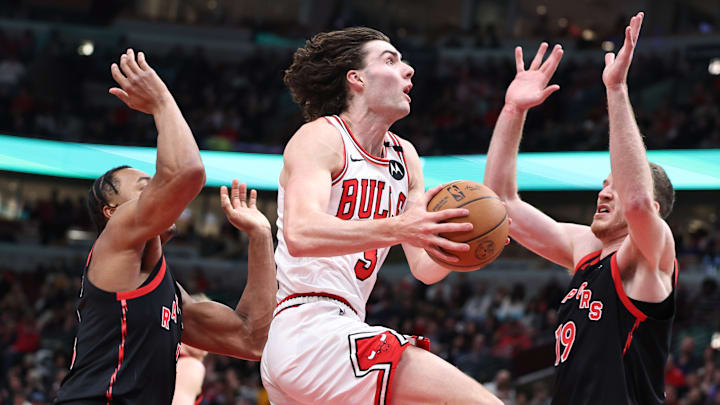When the Chicago Bulls traded for then-21-year-old Josh Giddey, they saw something. They had to since the organization parted ways with a beloved member and all-time teammate, Alex Caruso. Caruso brought a fiery competitiveness that's observed few and far between in the NBA. Yet, the Bulls dealt him in exchange for a player who had seemingly plateaued.
After being drafted sixth overall in 2021, Giddey hit the ground running as a rookie, albeit for a subpar Oklahoma City Thunder squad. The reigning NBA Champions managed a meager 24 wins in Giddey's rookie season. Nonetheless, with an abundance of playing time to go around, Giddey started in all 54 appearances and averaged a career-high 31.5 minutes per game.
Josh Giddey's play plateaued with a lack of volume in Oklahoma City
The Aussie totaled 12.5 points, 7.8 rebounds, and 6.4 assists per game. However, he struggled with efficiency. Giddey shot 41.9 percent from the field and 26.3 percent from three-point range. The 6-foot-8 guard’s 47.8 true shooting percentage ranked him 196th among 198 qualifiers.
A year later, Giddey improved all-around. His point production jumped to a career-high 16.6 per game, and he shot more efficiently, recording a true shooting percentage of 53.3 percent—177th among 201 qualifiers.
Then came Giddey's worst season as the Thunder improved as a whole. Giddey shot the ball with greater efficiency, but he averaged only 12.3 points per game, and his assists decreased to a career low at 4.8 per contest. Despite maintaining a similar usage rate and three-point shooting volume, Giddey’s downturn in production was driven largely by a career low in drives per game.
As follows, Giddey's average in drives per game went: 11.9, 12.4, and then to 7.1. The Aussie relied heavily on assists from others, as his percentage of twos via assists eclipsed 50 percent for the first time in his young career. For reference, only 30.2 percent of his twos in 2021-22 and 36.3 percent of his twos in 2022-23 were assisted on.
Perhaps most damning, Giddey had been increasing both his three-point and, most importantly, his field goal percentage on drives every season. Giddey shot 44.1 percent on 11.9 drives as a rookie; 48.3 percent on 12.4 drives as a sophomore; then, 49.3 percent on 7.1 drives in his third season. Moreover, his turnover percentage skyrocketed to 8.0 percent—a three percent increase from his second to third seasons.
Attacking the rim more often has only improved Giddey's game
With fewer driving opportunities, Giddey attempted to do too much, thus leading to an increase in turnovers. Yet, he still converted his shot attempts from drives at a high rate. There was far more to Giddey’s game waiting to be tapped into, but with Shai Gilgeous-Alexander commanding the offense and Jalen Williams emerging as a secondary star, the Aussie was often reduced to a connective playmaker and spot-up option. A role that he wasn't comfortable in.
Giddey’s initial stretch in Chicago mirrored the version of him that closed out his time in Oklahoma City. He averaged only 8.9 drives per game prior to the All-Star break. Yet, he shot a quality 47.5 percent on drives and held a sky-high 13.8 percent assist percentage whenever he did decide to attack the rim.
Following the All-Star break, Giddey leaned on what sparked his early-career growth—boosted confidence and a more aggressive driving approach. After the midseason festivities, Giddey averaged 16.0 drives per game. 8.5 points, as opposed to 3.6, came via drives after the All-Star break. Additionally, he increased his field-goal percentage on drives from 47.5 to 51.3, all while maintaining a consistent assist rate and cutting down on turnovers.
When Giddey's confident and assertive, he plays his best. Of course, the same can be said of any player. But Giddey's decisiveness opens up so many other components of his game. As he became more of a threat to drive, keeping opposing defenders on their toes, he shot better from beyond the arc.
Giddey should continue, and perhaps even ramp up, the number of times he drives to the basket. Among 11 players to average 15.0 or more drives per game post All-Star, Giddey attempted the fewest field goals per drive. Being even more aggressive is the next step for Giddey. He’s already proven he can score efficiently and set up teammates; increasing his field-goal attempts would elevate his game even further.
